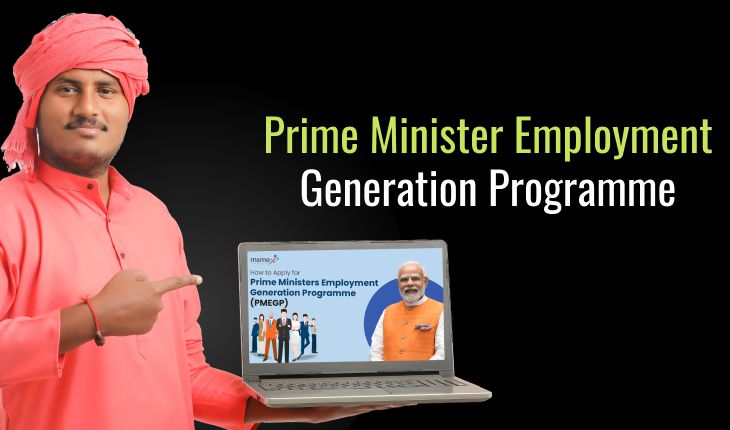Prime Minister Employment Generation Programme

Last Updated : Nov. 14, 2022, 3:16 p.m.
With the increase in the competition for sustainability in the world, developing countries face issues like unemployment in this century. Because of the uncontrollable birth rate, India is facing the problem of unemployment significantly.
This problem is pulling down the rate of economic development and growth and increasing the poverty level in the country. However, the government of India has launched many programmes and schemes to provide citizens with financial assistance and business training to eradicate this problem.
PMEGP is also a part of such programmes. Please read this article to perceive this scheme and learn its benefits!
Overview of the PMEGP Scheme
In 2008, the Ministry of MSME launched a programme, PMEGP (Prime Minister’s Employment Generation Programme), to assist India’s citizens with the unemployment problem.
This scheme is carried out by KVIS, i.e., Khadi and Village Industries Commission at the national level. The main target of this scheme is to provide employment opportunities in the urban and rural areas of India.
According to this scheme, the Government of India will provide credit aid and subsidies on loans to the applicants at some rate via banks. Applicants from urban and rural with a category of both general and special are applicable for this scheme. However, under this scheme, only one family member can obtain financial aid. Moreover, assistance is available only for new projects.
What Is the Eligibility Parameter for the PMEGP Scheme?
Although this scheme provides financial assistance to individuals and institutions, some parameters decide whether you are eligible to earn benefits with PMEGP or not. Some such standards are given below:
- The minimum age of any individual must be 18 years.
- There is no income apex for setting any project under the PMEGP scheme.
- There are no educational criteria for manufacturing sector projects upto ₹10,00,000. However, the applicant must possess a pass education of at least VIII standard for above this amount.
- For any service sector project, an applicant has no educational restriction upto ₹5,00,000. However, the applicant must have passed education of at least VIII standard for an amount above this.
- The units already under or availed any Government Subsidy under any State or Central Government of India schemes are not applicable for this scheme.
The other eligible entities are given below:
- Co-operative Societies involved in production activities.
- Charitable Trusts.
- Self-Help Groups (with those that fall BPL, however, those are receiving benefits from some other Government schemes).
- Societies recorded under the Societies Registration Act of 1860.
What Documents Are Required While Applying for the PMEGP Scheme?
Apart from the application, some documents are needed to attach to the application under the PMEGP scheme.
The documents list for individuals is given below:
- Caste or Community Certificate to prove the category you applied for.
- In the case of minorities, Special Category Certificate.
- Aadhaar card/ PAN card / Voter ID, etc., for identity and address proof.
- Skill Development training/ EDP/ Education Certificate.
- Project Report for one capital expenditure cycle and component of working capital.
- If a working capital component is not present, an approval letter from the controlling office of the concerned bank is.
- Training certificate of Entrepreneurship Development Programme.
The documents listed for an organisation are given below
- Registration Certificate of the institution.
- If applicable, Certificate of Special Category.
- An authorisation letter or Photocopy of bye-laws allows the Secretary to apply for permits.
How to Apply for the PMEGP Loan Programme?
Given below steps will assist you through the action of applying for the loan under the PMEGP scheme:
Step 1: Go through the official website of the MSME scheme for the application form.
Step 2: Choose PMEGP e-Portal and get your User ID and password.
Step 3: Enter your ID and password and click the ‘Online Application Form’ option. Select individual form.
Step 4: Enter your name, age, address, etc., details.
Step 5: Attach the required documents with your application.
Step 6: Attach your clear and recent photograph with the application.
Step 7: Enter your activity name and product details.
Step 8: Submit your bank details and the purpose of applying for a loan.
Step 9: Click on the ‘Submit’ option. Step 10: Then submit other remaining details via the PMEGP portal.
What Are the Benefits of the PMEGP Scheme?
This scheme also provides some benefits that are given below:
- In the non-farm sector, bank-financed subsidy programmes are offered under this scheme to encourage new microenterprises.
- At 15% to 35% bank loan ranges, get Margin Money subsidy upto ₹50,00,000 for manufacturing sector projects and ₹20,00,000 for service sector projects.
- For special categories such as SC, ST, physically handicapped, women, minorities, NER, or Ex-servicemen, the benefits of the Margin Money subsidy is upto 25% in urban areas and 35% in rural areas.
At the End
Although many schemes and programmes launched by the Government of India have benefited the citizens and reduced the unemployment rate, the PMEGP programme is leading this race. The youth of the country are getting many advantages under this scheme. It also uplifts the MSME sector.
